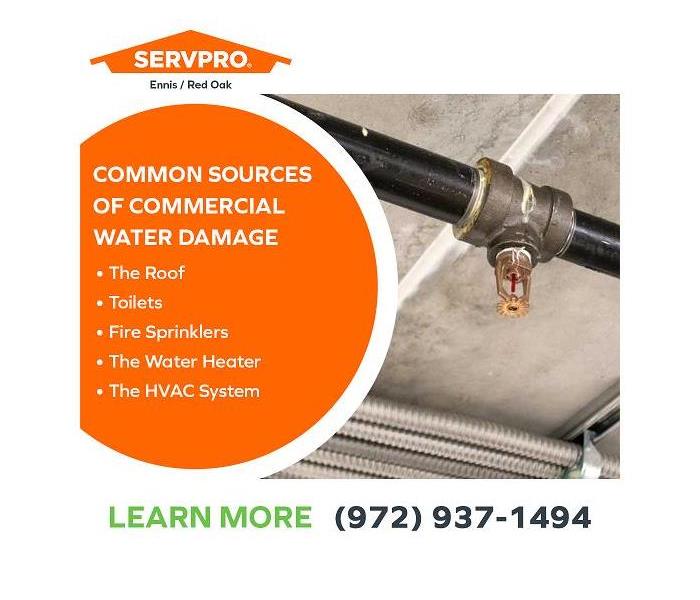Five Frequent Sources of Water Intrusion and Water Damage in Local Businesses
7/8/2022 (Permalink)
Blog Summary: SERVPRO of Ennis/Red Oak highlights common causes of water damage in commercial facilities in the Corsicana, TX, area.
SERVPRO of Ennis/Red Oak provides commercial flood damage restoration for businesses in the Corsicana, TX, area. A rapid response after flooding enables a company to resume normal business operations, and quick action may mean the survival of the business.
A typical business is exposed to water damage on many fronts, and the damage may come from either a water release (internal) or a water intrusion (external). At times, the two vulnerabilities may overlap, but understanding the differences can facilitate a more effective prevention, repair, and recovery strategy.
To form a clearer picture of the areas at risk of water damage in Corsicana, TX, commercial facilities, here is an outline of the most common sources of commercial water damage disasters and practical prevention strategies to reduce the risk.
Common sources of commercial water damage
1. The Roof
The most common source of water damage in a commercial setting is the roof. A water intrusion through the roof accounts for approximately 15% of commercial water damage claims. Potential leak points dot a typical commercial roof. Examples include ventilation fans, skylights, waste removal conduit, ingress/egress doors, and innumerable nuts and bolts to hold brackets and support beams for rooftop structures. Roof perforations can easily number in the hundreds for an industrial facility. Roof leaks are the leading cause of ceiling water damage.
The key to reducing or eliminating roof leaks is a comprehensive plan of regular and occasional inspection and maintenance. Severe weather involving ice and snow, high winds, hail, or heavy rain should prompt a visual inspection of the roof for structural damage that could result in a water intrusion. Pooling water on a flat roof may indicate a clogged drainage system, and failure to unclog the system could lead to a catastrophic roof collapse. The inspection should include an examination of leaks and drip points inside the facility. An intermittent drip can short circuit an electrical panel or ruin expensive equipment in the company’s data center. Repairs should be immediately performed and duly noted since leak sites are often repeat offenders.
2. Toilets
Toilets can create a major mess, especially in multi-story complexes with stacked plumbing. Scheduled inspections, vigilance between inspections, pre-emptive replacements of supply lines every three to five years, and the immediate repair of any issues can stem the tide of water damage disasters resulting from plumbing issues (15% of loss claims).
3. Fire Sprinklers
A fire sprinkler system dispenses water to control or extinguish a fire. (A fire suppression system uses gaseous, chemical, or foam fire suppression agents to control or extinguish a fire.) Less expensive than a fire suppression system and very effective at putting out fires, sprinklers malfunction often enough to account for one in seven (14%) commercial water damage losses.
The tradeoff for economy and effectiveness is regular inspections, perpetual monitoring, and immediate maintenance. The deep freeze in February of 2021 exposed the vulnerability of Texas to frozen pipes. As many as 1.2 million people experienced frozen pipes, and businesses had to endure a similar fate.
Anti-freeze low-temperature alert systems, sprinkler heads, and pipes should be checked before, during, and after the coldest months of the year. A late winter or early spring cold blast can make a fire sprinkler system a foe rather than a friend. These core activities can keep the fire sprinkler system functional and safe.
- Inspect the entire system, including sprinkler heads, on a regular basis.
- Test system functionality as suggested by the company that installed the system.
- Replace critical parts before they create a water damage disaster.
- Repair leaks before they become a problem.
Take care of the fire sprinkler system, and it will take care of the building and save lives.
4. The Water Heater
With a lifespan estimated at only 7-10 years, a water heater is a water damage disaster waiting to happen. Avoid a disaster by replacing the appliance every seven to nine years. The installation of a drip pan can capture small leaks. An automatic shut-off valve installed near the heater can prevent a major water damage catastrophe.
5. The HVAC System
The HVAC system in a large office complex, professional building, or manufacturing facility is extensive. Frozen evaporator coils, clogged drains, cracked condensate pans, and installation errors make the HVAC system one of the leading causes of water damage in a commercial setting. The HVAC system requires regular inspections and maintenance to work effectively, efficiently, and safely. The maintenance supervisor or facility manager would do well to cultivate a close relationship with a reputable, licensed, insured, and bonded commercial HVAC installation and service company.
These top five causes of water damage in a commercial venue account for two-thirds of all water damage losses. Another relationship to establish is one with a qualified, reputable property damage cleanup and restoration company. Important criteria include:
- Available 24/7, 356 days a year, including holidays
- Rapid response time of about an hour
- Able to scale to any size and type of disaster
- Locally owned and operated
- IICRC certifications
- Bonded, licensed, and insured
- Positive reviews and references
When a business faces the disruption of a water damage disaster, a quickly-implemented water damage restoration process is critical. Business operations need to return to normal as soon as possible to avoid loss of customers, employee displacement, and disruption of the revenue cycle.
Contact SERVPRO of Ennis/Red Oak to learn more about the company’s flood damage restoration and cleanup services. The office can be reached by emailing acarey@SERVPRO10932.com or calling (972) 937-1494.


 24/7 Emergency Service
24/7 Emergency Service
